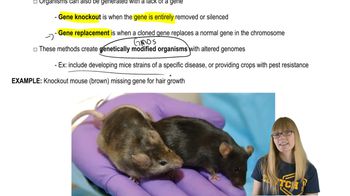One complication of making a transgenic animal is that the transgene may integrate at random into the coding region, or the regulatory region, of an endogenous gene. What might be the consequences of such random integrations? How might this complicate genetic analysis of the transgene?
Table of contents
- 1. Introduction to Genetics51m
- 2. Mendel's Laws of Inheritance3h 37m
- 3. Extensions to Mendelian Inheritance2h 41m
- 4. Genetic Mapping and Linkage2h 28m
- 5. Genetics of Bacteria and Viruses1h 21m
- 6. Chromosomal Variation1h 48m
- 7. DNA and Chromosome Structure56m
- 8. DNA Replication1h 10m
- 9. Mitosis and Meiosis1h 34m
- 10. Transcription1h 0m
- 11. Translation58m
- 12. Gene Regulation in Prokaryotes1h 19m
- 13. Gene Regulation in Eukaryotes44m
- 14. Genetic Control of Development44m
- 15. Genomes and Genomics1h 50m
- 16. Transposable Elements47m
- 17. Mutation, Repair, and Recombination1h 6m
- 18. Molecular Genetic Tools19m
- 19. Cancer Genetics29m
- 20. Quantitative Genetics1h 26m
- 21. Population Genetics50m
- 22. Evolutionary Genetics29m
15. Genomes and Genomics
Genomics and Human Medicine
Problem 26
Textbook Question
What techniques can scientists use to determine if a particular transgene has been integrated into the genome of an organism?
 Verified step by step guidance
Verified step by step guidance1
Step 1: Scientists can use Polymerase Chain Reaction (PCR) to amplify specific DNA sequences. Design primers that target the transgene sequence and perform PCR on the organism's genomic DNA. If the transgene is present, the PCR will produce a detectable product.
Step 2: Perform Southern blot analysis. Extract genomic DNA from the organism, digest it with restriction enzymes, and separate the fragments using gel electrophoresis. Transfer the DNA to a membrane and hybridize it with a labeled probe specific to the transgene sequence. The presence of the transgene will be indicated by a signal on the blot.
Step 3: Use fluorescence in situ hybridization (FISH). Prepare chromosome spreads from the organism and hybridize them with fluorescently labeled probes specific to the transgene. Under a fluorescence microscope, the transgene's integration site can be visualized.
Step 4: Conduct quantitative PCR (qPCR) to measure the copy number of the transgene. This technique can confirm not only the presence but also the relative abundance of the transgene in the genome.
Step 5: Perform whole-genome sequencing or targeted sequencing. Sequence the organism's genome and analyze the data to identify the integration site and confirm the presence of the transgene.
 Verified video answer for a similar problem:
Verified video answer for a similar problem:This video solution was recommended by our tutors as helpful for the problem above
Video duration:
2mPlay a video:
Was this helpful?
Key Concepts
Here are the essential concepts you must grasp in order to answer the question correctly.
Transgene Integration
Transgene integration refers to the process by which a foreign gene (transgene) is incorporated into the genome of an organism. This can occur through various mechanisms, such as homologous recombination or non-homologous end joining. Understanding how transgenes integrate is crucial for assessing their stability and expression in the host organism.
Recommended video:
Guided course

Transgenic Organisms and Gene Therapy
Molecular Techniques
Molecular techniques are laboratory methods used to analyze DNA, RNA, and proteins. Techniques such as PCR (Polymerase Chain Reaction), Southern blotting, and sequencing are commonly employed to confirm the presence of a transgene in an organism's genome. These methods allow scientists to detect specific sequences and assess whether the transgene has been successfully integrated.
Recommended video:
Guided course

Mapping with Markers
Genomic Analysis
Genomic analysis involves examining the complete DNA sequence of an organism to identify genetic variations, including the presence of transgenes. Techniques like whole-genome sequencing and comparative genomic hybridization can provide insights into the integration sites and potential effects of transgenes on the host genome. This analysis is essential for understanding the implications of genetic modifications.
Recommended video:
Guided course

Chi Square Analysis

 6:51m
6:51mWatch next
Master Human Genome Composition with a bite sized video explanation from Kylia
Start learningRelated Videos
Related Practice
Textbook Question
405
views
